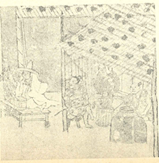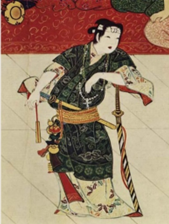Kyoto’s spring, “Miyako Odori” and the modernization of Kyoto III The roots of maiko and teahouses
Yoshie Doi
 Illustrated Map of Gion Omandokoro |
 Illustrated Map of Gion Omandokoro |
| Teahouse consists with branches removed and the temporary roof on the wooden pillars covered with mats in front of the gate |
 |
 |
 |
| Kuniyoshi Ichiyusai, Juzo Joshuya, “The Sixty-odd Provinces of Great Japan” Izumo no Okuni drawn by Utagawa Kuniyoshi Izumo Okuni” (owned by the National Diet Library) “National Diet Library Digital Collections | The statue of Okuni in the east of Shijo Ohashi (photographed on February 27, 2023) |
A long time ago, about 30 years ago, I talked with a maiko in Gion and heard that “the maiko of Gion Kobu can dance in front of the emperor.” I was surprised about this. What will the era of Reiwa be like? The number of geisha and maiko in Kyoto’s five geisha districts (Kamishichiken, Pontocho, Miyagawacho, Gion Kobu, and Gion Higashi) is also declining, so I don’t think anyone would say that.
When he was Governor of Tokyo Ishihara, I received a request from the Tokyo metropolitan government to visit Kyoto, and I was given the opportunity to guide him on a tight schedule to see if there was anything Tokyo could accept from Kyoto’s traditional industries. Among them, there was a project that he wanted to know about the revitalization of Hanamachi and the financial situation.
There, I witnessed a maiko (apprentice geisha) performance (a maiko debut) in Miyagawa-cho. At this time, I learned that there are many cases where people who are not from Kyoto aspire to become maiko. A maiko born in Beijing, a geisha who graduated from university and worked at a trading company before becoming a geisha. I had a very valuable conversation and learned that in a unique world, Japanese family ties still exist in this world.
Usually, they live in an okiya during junior high school or after graduation, and from the training period called “Shikomi-san” to the debut at the show, they are trained to become familiar with the world of tradition, learning the Kyoto language, learning etiquette and performing arts, and living alone. They’re going to come out themselves on an Ozashiki. Read the overall mood, grow to be able to provide the best hospitality of their performing arts.
Yasaka Shrine, known as “Gion Kanjin-in”, was a branch temple of Mt. Hiei’s Enryaku-ji Temple. Gion’s maiko have their roots in the beginning of the Edo period, when Gion began as a teahouse that was built as a resting place for visitors to Kiyomizu-dera and Kiyomizu-dera.
The roots of women who entertain with singing and dancing music can be seen in the Shirabyoshi of the Heian period. In addition, Izumo no Okuni in the Edo period is also known as Japan’s first female idol, and is a woman who took the world by Yayako Odori (An imitation baby dance).
In the 16th century, mizuchaya, which served tea to visitors to Yasaka Shrine, began offering tea sweets, sake, and even music and dance music. There was a teahouse that exceeded the eaves. This is the root of Gion. Until the Meiji era, both Gion Kobu and Gion Higashi were one, but the government divided them into Kobu and Otobe, and Otobe changed its name to Gion Higashi.
Kamishichiken, which has the longest history among Kyoto’s five geisha districts (Kamishichiken, Pontocho, Miyagawacho, Gion Kobu, and Gion Higashi), had surplus wood was paid out to kamishichiken when Kitano Tenmangu Shrine was rebuilt in the Muromachi period. Kamishichiken came to be called Kamishichiken because of the seven teahouses he built. When Hideyoshi held a large tea ceremony at Kitano Tenmangu Shrine, this tea house became a resting place and was given the right to operate a tea house.
Mizuchaya began to serve sake and food at night, and before long, a night specialty shop was opened, which was the beginning of today’s teahouses. Before long, the women who worked here began to play the shamisen and dance, and the town developed further.
The bustle of the area grew steadily, and teahouses began to line up near Shimbashi, where the Gion area of Shijo was once a field, and finally reached its peak in the early 1800s, during the Bunka and Bunsei eras.
The end of document
